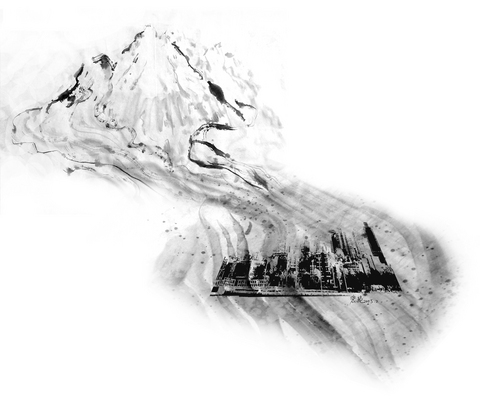Up and down the icy spine of South America, the glaciers are melting, the white mantle of the Andes Mountains washing away at an ever faster rate.
"Look. You can see. Chacaltaya has split in two," scientist Edson Ramirez said as he led a visitor up toward the once-grand ice flow, predicting the glacier would be gone in seven to eight years.

And the ice masses are disappearing far beyond Bolivia. From Alaska in the north, to Montana's Glacier National Park, to the great ice fields of wild Patagonia at this continent's southern tip, the "rivers of ice" that have marked landscapes from prehistory are liquefying, shrinking, retreating.
City Survival
In the distance below, beneath drifting clouds, sprawled 3,660m-high La Paz, a growing city that survives on the water running off the shoulders of these treeless peaks.
Chacaltaya, a frozen storehouse of such water, will be gone in seven to eight years, said Ramirez, a Bolivian glaciologist, or ice specialist.
"Some small glaciers like this have already disappeared," he said as melting icicles dripped on nearby rock, exposed for the first time in millennia. "In the next 10 years, many more will."
In east Africa, the storied snows of Mount Kilimanjaro are vanishing. In the icebound Alps and Himalayas of Europe and Asia, the change has been stunning. From South America to south Asia, new glacial lakes threaten to overflow and drown villages below.
In the past few years, space satellites have helped measure the global trend, but scientists such as Rajendra Pachauri, a native of north India, have long seen what was happening on the ground.
"I know from observation," Pachauri told a reporter at an international climate conference in Argentina. "If you go to the Himalayan peaks, the rate at which the glaciers are retreating is alarming. And this is not an isolated example. I've seen photographs of Mount Kilimanjaro 50 years ago and now. The evidence is visible."
"Ample" evidence indicates that global warming is causing glaciers to retreat worldwide, reports the Intergovernmental Panel on Climate Change, a UN-sponsored network of climate scientists led by Pachauri.
Global temperatures rose about 0.6?C in the 20th century. French glaciologists working with Ramirez and other scientists at La Paz's San Andres University estimate that the Bolivian Andes are warming even faster, currently at 0.3?C per decade.
The warming will continue as long as "greenhouse gases," primarily carbon dioxide from the burning of fossil fuels, accumulate in the atmosphere, say the UN panel and other authoritative scientific organizations.
The Kyoto Protocol, an international agreement, mandates cutbacks in such emissions, but the reductions are small and the US, the biggest emitter, is not a party, arguing that the mandates will set back the US economy.
As that pact takes effect Feb. 16, the impact of climate change is already apparent.
An international study concluded in November that winter temperatures have risen as much as 4?C over 50 years in the Arctic, where permafrost is thawing and sea ice is shrinking. Pacific islands are losing land to encroaching seas, oceans expanding as they warm and as they receive runoff from the Greenland ice cap and other sources.
Those sources include at least one gushing new river of meltwater in western China, where thousands of Himalayan and other glaciers are shrinking. In the Italian Alps, 10 percent of the ice melted away in the European heat wave of 2003 and experts fear all will be gone in 20 to 30 years.
Such rapid runoff would do more than feed rising seas. It would end centuries of reliable flows through populated lands, jeopardizing water supplies for human consumption, agriculture and electricity.
In Peru, endowed with vast Andean ice caps and glaciers, 70 percent of the power comes from hydroelectric dams catching runoff, but officials fear much of it could be gone within a decade. Meanwhile, new mountainside lakes are bulging from the melt, threatening to break their banks and devastate nearby towns.
Here in impoverished Bolivia, the government has barely begun to plan for climate change.
Water Assessments
Tomas Quisbert, a hydrological engineer with the water company serving the 2 million people of the La Paz region, said 95 percent of its supplies come from the mountains, either from rain runoff or glacier melt.
"But we can't say precisely how much comes from the glaciers," he said.
Ramirez and fellow scientists are seeking government support to do a complete assessment of water in the La Paz basin, linked to computer modeling of future regional climate and its impact.
They'll soon move on from 5,300m-high Chacaltaya -- "Cold Road" in the native Aymara language -- as it shrinks toward oblivion. But in 13 years of intense study of the glacier, the scientists have gathered a rich lode of data representative of countless small glaciers across the region.
A rugged hour's drive up from La Paz, with a simple mountain lodge beside it, Chacaltaya was once the world's highest ski slope. But no one has skied down its tongue of snow-coated ice since 1998. The melt has exposed rock right across its midsection, splitting the glacier in two.
It covers an area of less than six hectares, with ice less than 7.8m thick. Ramirez said it lost two-thirds of its mass in the 1990s alone, and is now probably 2 percent the size it once was.
Chacaltaya and other Andean glaciers had been retreating since the 18th century, when the "Little Ice Age" ended locally, but the rate has picked up dramatically in recent decades, melting three times faster since the 1980s than in the mid-20th century.
Although rising temperatures are an underlying factor, glaciologists find a complex cycle at work: A warming Pacific Ocean has created disruptive El Nino climate periods more frequently and powerfully, reducing precipitation, including snows to replenish glaciers. Less snow also means glaciers that are less white, more gray, absorbing more heat. Newly exposed rock walls then act like an oven to further speed melting.
Whatever the regional wrinkles, "it's a global view," said Lonnie Thompson, one of the world's foremost glaciologists.
"What we see in the Andes is happening in Kilimanjaro and in the Himalayas. We've just been in southeast Alaska, and 1,987 out of 2,000 glaciers are retreating there," the Ohio State University scientist said in a telephone interview from Columbus.
"It's a very compelling story," he said. The glaciers -- "water towers of the world" -- are the most visible indicators that we are now in the first phase of global warming, Thompson said.
We are used to hearing that whenever something happens, it means Taiwan is about to fall to China. Chinese President Xi Jinping (習近平) cannot change the color of his socks without China experts claiming it means an invasion is imminent. So, it is no surprise that what happened in Venezuela over the weekend triggered the knee-jerk reaction of saying that Taiwan is next. That is not an opinion on whether US President Donald Trump was right to remove Venezuelan President Nicolas Maduro the way he did or if it is good for Venezuela and the world. There are other, more qualified
The immediate response in Taiwan to the extraction of Venezuelan President Nicolas Maduro by the US over the weekend was to say that it was an example of violence by a major power against a smaller nation and that, as such, it gave Chinese President Xi Jinping (習近平) carte blanche to invade Taiwan. That assessment is vastly oversimplistic and, on more sober reflection, likely incorrect. Generally speaking, there are three basic interpretations from commentators in Taiwan. The first is that the US is no longer interested in what is happening beyond its own backyard, and no longer preoccupied with regions in other

Jan. 1 marks a decade since China repealed its one-child policy. Just 10 days before, Peng Peiyun (彭珮雲), who long oversaw the often-brutal enforcement of China’s family-planning rules, died at the age of 96, having never been held accountable for her actions. Obituaries praised Peng for being “reform-minded,” even though, in practice, she only perpetuated an utterly inhumane policy, whose consequences have barely begun to materialize. It was Vice Premier Chen Muhua (陳慕華) who first proposed the one-child policy in 1979, with the endorsement of China’s then-top leaders, Chen Yun (陳雲) and Deng Xiaoping (鄧小平), as a means of avoiding the
As technological change sweeps across the world, the focus of education has undergone an inevitable shift toward artificial intelligence (AI) and digital learning. However, the HundrED Global Collection 2026 report has a message that Taiwanese society and education policymakers would do well to reflect on. In the age of AI, the scarcest resource in education is not advanced computing power, but people; and the most urgent global educational crisis is not technological backwardness, but teacher well-being and retention. Covering 52 countries, the report from HundrED, a Finnish nonprofit that reviews and compiles innovative solutions in education from around the world, highlights a